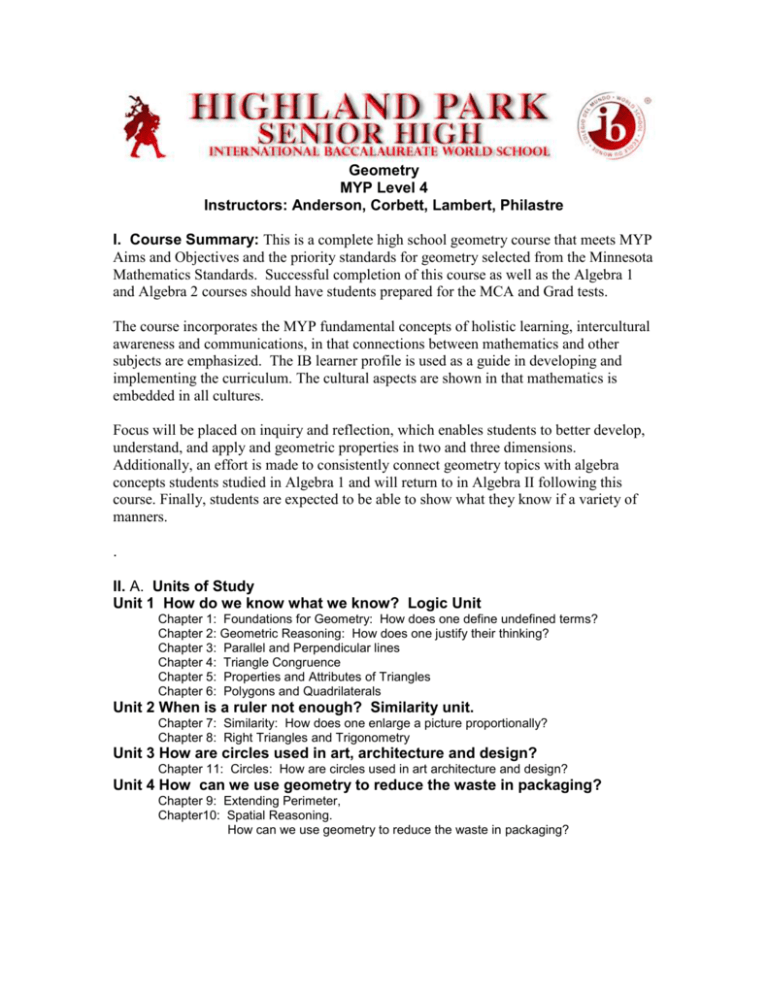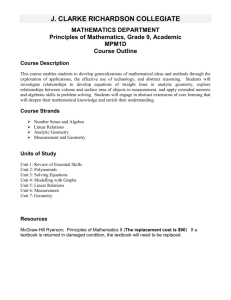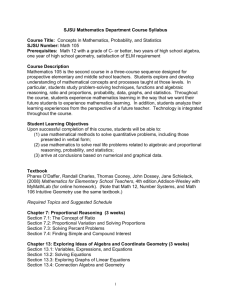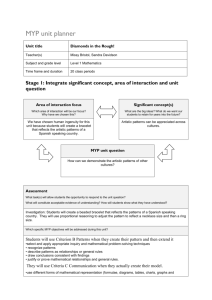Geometry - Highland Park Senior High School
advertisement

Geometry MYP Level 4 Instructors: Anderson, Corbett, Lambert, Philastre I. Course Summary: This is a complete high school geometry course that meets MYP Aims and Objectives and the priority standards for geometry selected from the Minnesota Mathematics Standards. Successful completion of this course as well as the Algebra 1 and Algebra 2 courses should have students prepared for the MCA and Grad tests. The course incorporates the MYP fundamental concepts of holistic learning, intercultural awareness and communications, in that connections between mathematics and other subjects are emphasized. The IB learner profile is used as a guide in developing and implementing the curriculum. The cultural aspects are shown in that mathematics is embedded in all cultures. Focus will be placed on inquiry and reflection, which enables students to better develop, understand, and apply and geometric properties in two and three dimensions. Additionally, an effort is made to consistently connect geometry topics with algebra concepts students studied in Algebra 1 and will return to in Algebra II following this course. Finally, students are expected to be able to show what they know if a variety of manners. . II. A. Units of Study Unit 1 How do we know what we know? Logic Unit Chapter 1: Foundations for Geometry: How does one define undefined terms? Chapter 2: Geometric Reasoning: How does one justify their thinking? Chapter 3: Parallel and Perpendicular lines Chapter 4: Triangle Congruence Chapter 5: Properties and Attributes of Triangles Chapter 6: Polygons and Quadrilaterals Unit 2 When is a ruler not enough? Similarity unit. Chapter 7: Similarity: How does one enlarge a picture proportionally? Chapter 8: Right Triangles and Trigonometry Unit 3 How are circles used in art, architecture and design? Chapter 11: Circles: How are circles used in art architecture and design? Unit 4 How can we use geometry to reduce the waste in packaging? Chapter 9: Extending Perimeter, Chapter10: Spatial Reasoning. How can we use geometry to reduce the waste in packaging? II. B. State Standards, MYP Aims and Objectives The state standards for High School geometry are: 1) Calculate measurements of plane and solid geometric figures; know that physical measurements depend on the choice of a unit and that they are approximations 2) Know and apply properties of geometric figures to solve real world and mathematical problems and to logically justify results in geometry. 3) Solve real-world and mathematical geometric problems using algebraic methods. The MYP aims of teaching and learning mathematics include encouraging students to: 1) Appreciate the usefulness and power of mathematics 2) Enjoy math and develop perseverance 3) Be able to communicate using mathematical notation 4) Develop knowledge, and thinking skills 5) Recognize the presence of mathematics in their lives Over the course of the year students will achieve the MYP objectives of: 1) Acquiring knowledge and understanding 2) Be able to recognize and investigate patterns 3) Communicate effectively using mathematical language and notation 4) Reflect upon their work and conclusions. III. Areas of Interactions Throughout the course, the areas of interaction (Approaches to Learning, Community and Service, Human Ingenuity, Environments, Health and Social Education) will be used as a way to insure that students have meaningful learning experiences. It is desired that every area of interaction be utilized at least once during the year to focus the students learning. It will be used as a lens in which students will view a particular unit of study. IV. Texts 1. Holt Geometry textbook. 2. Student workbook pages from the Holt series including the Homework and Practice workbook, Problem Solving workbook and Know-It Notebook. 3. Holt’s MCA-II practice work book. V. Methodology All teachers of this course will work together to apply a variety of teaching methods. Collaboration will include utilizing common assessments, sharing of projects, having a similar grading structure and sharing of effective teaching strategies. The MYP philosophy will be used as the foundation upon which to build. VI. Methods of Assessment Teachers will regularly use both formative and summative assessments to gauge and guide student success. Routine formative assessments will evaluate student progress and inform instruction. Among other strategies teachers may choose to use exit cards, math review problems, visual checks for understanding (thumbs up, note cards, etc.), quick writes, quizzes, homework checks or discussion. Summative assessments will commonly take the form of chapter tests, unit tests, and/or group or individual problem solving. Cumulative final exams may also be given. VII. Grading and Reporting Grades will be given at the conclusion of each semester with a progress grade given midway through the semester. All grades will be given based upon the percentage of points earned on the measures of assessment. The assessments will be based upon the aforementioned objectives and will include the MYP assessment criteria. A: Knowledge and understanding B: Investigating patterns C: Communications in mathematics D: Reflection in mathematics






